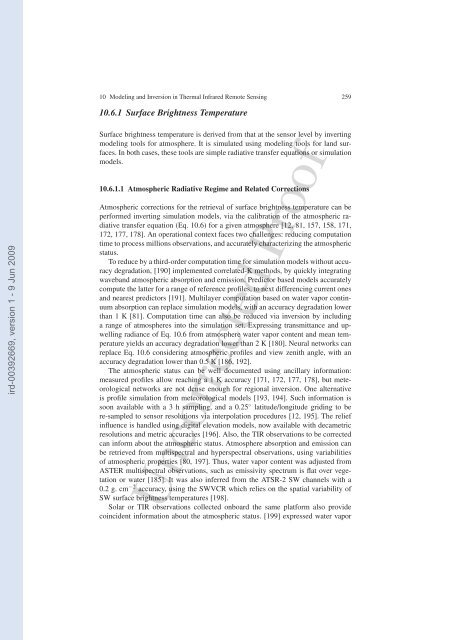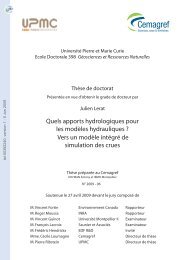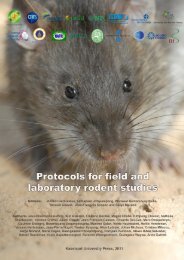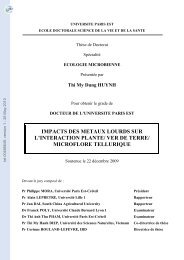Modeling and Inversion in Thermal Infrared Remote Sensing over ...
Modeling and Inversion in Thermal Infrared Remote Sensing over ...
Modeling and Inversion in Thermal Infrared Remote Sensing over ...
You also want an ePaper? Increase the reach of your titles
YUMPU automatically turns print PDFs into web optimized ePapers that Google loves.
10 <strong>Model<strong>in</strong>g</strong> <strong>and</strong> <strong>Inversion</strong> <strong>in</strong> <strong>Thermal</strong> <strong>Infrared</strong> <strong>Remote</strong> Sens<strong>in</strong>g 25910.6.1 Surface Brightness Temperatureird-00392669, version 1 - 9 Jun 2009Surface brightness temperature is derived from that at the sensor level by <strong>in</strong>vert<strong>in</strong>gmodel<strong>in</strong>g tools for atmosphere. It is simulated us<strong>in</strong>g model<strong>in</strong>g tools for l<strong>and</strong> surfaces.In both cases, these tools are simple radiative transfer equations or simulationmodels.10.6.1.1 Atmospheric Radiative Regime <strong>and</strong> Related CorrectionsAtmospheric corrections for the retrieval of surface brightness temperature can beperformed <strong>in</strong>vert<strong>in</strong>g simulation models, via the calibration of the atmospheric radiativetransfer equation (Eq. 10.6) for a given atmosphere [12, 81, 157, 158, 171,172, 177, 178]. An operational context faces two challenges: reduc<strong>in</strong>g computationtime to process millions observations, <strong>and</strong> accurately characteriz<strong>in</strong>g the atmosphericstatus.To reduce by a third-order computation time for simulation models without accuracydegradation, [190] implemented correlated-K methods, by quickly <strong>in</strong>tegrat<strong>in</strong>gwaveb<strong>and</strong> atmospheric absorption <strong>and</strong> emission. Predictor based models accuratelycompute the latter for a range of reference profiles, to next differenc<strong>in</strong>g current ones<strong>and</strong> nearest predictors [191]. Multilayer computation based on water vapor cont<strong>in</strong>uumabsorption can replace simulation models, with an accuracy degradation lowerthan 1 K [81]. Computation time can also be reduced via <strong>in</strong>version by <strong>in</strong>clud<strong>in</strong>ga range of atmospheres <strong>in</strong>to the simulation set. Express<strong>in</strong>g transmittance <strong>and</strong> upwell<strong>in</strong>gradiance of Eq. 10.6 from atmosphere water vapor content <strong>and</strong> mean temperatureyields an accuracy degradation lower than 2 K [180]. Neural networks canreplace Eq. 10.6 consider<strong>in</strong>g atmospheric profiles <strong>and</strong> view zenith angle, with anaccuracy degradation lower than 0.5 K [186, 192].The atmospheric status can be well documented us<strong>in</strong>g ancillary <strong>in</strong>formation:measured profiles allow reach<strong>in</strong>g a 1 K accuracy [171, 172, 177, 178], but meteorologicalnetworks are not dense enough for regional <strong>in</strong>version. One alternativeis profile simulation from meteorological models [193, 194]. Such <strong>in</strong>formation issoon available with a 3 h sampl<strong>in</strong>g, <strong>and</strong> a 0.25 ◦ latitude/longitude grid<strong>in</strong>g to bere-sampled to sensor resolutions via <strong>in</strong>terpolation procedures [12, 195]. The relief<strong>in</strong>fluence is h<strong>and</strong>led us<strong>in</strong>g digital elevation models, now available with decametricresolutions <strong>and</strong> metric accuracies [196]. Also, the TIR observations to be correctedcan <strong>in</strong>form about the atmospheric status. Atmosphere absorption <strong>and</strong> emission canbe retrieved from multispectral <strong>and</strong> hyperspectral observations, us<strong>in</strong>g variabilitiesof atmospheric properties [80, 197]. Thus, water vapor content was adjusted fromASTER multispectral observations, such as emissivity spectrum is flat <strong>over</strong> vegetationor water [185]. It was also <strong>in</strong>ferred from the ATSR-2 SW channels with a0.2 g. cm −2 accuracy, us<strong>in</strong>g the SWVCR which relies on the spatial variability ofSW surface brightness temperatures [198].Solar or TIR observations collected onboard the same platform also provideco<strong>in</strong>cident <strong>in</strong>formation about the atmospheric status. [199] expressed water vaporUncorrected Proof
















